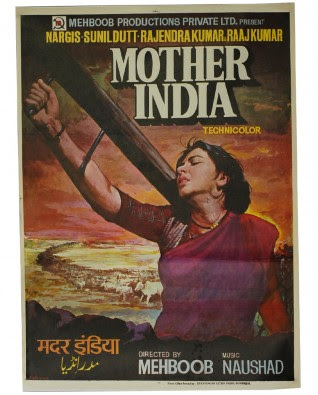Glamorous and provocative, the film posters of Bollywood have had a long and glorious history, which is only now being given the attention and recognition it richly deserves.On the streets of Mumbai, the film poster acts as an attractive, instant invitation to the pleasures of Bollywood. It is also a dynamic fusion, where the world’s most democratic art form meets one of the most exciting movie genres known.
The old posters often featured warm-red colors and princesslike actresses gazing into the air. The new posters mimic today's American movie posters.Posters depict Bollywood cinema's commitment to themes of social melodrama and mass entertainment. They also demonstrate with a clarity otherwise not grasped by the lay viewer that Bollywood cinema is its own richest archive.
Within these large themes of the posters however are a number of sub themes — the tussle between family honour and romantic love, the conflict between the rural countryside and the new urban metropolis, the rise of teenage love, female sexuality and the courtesan — that have dominated Hindi cinema.
For example, the posters of Anarkali (1953) and Aan (1952) draw attention to the themes of love and honour, as well as to the conditions of post-independence India (Aan) and India's pre-colonial Mughal history.
Similarly, the poster of Shree 420 (1955) demonstrates the impact of the Charlie Chaplin-inspired tramp image on India's own citizen hero Raj Kapoor.
The poster of the teenage romance Bobby clearly traces its lineage to romantic Hindi films of the 1950s romances such as Barsaat. Likewise it highlights the increasing acceptance of a 'Western' consumer culture among the urban Indian middle class first depicted in films such as Jewel Thief.
The posters of films from the 1990s, including Dil To Pagal Hai, Lagaan and Dilwale Dulhaniya Le Jayenge, celebrate India's embrace of global cosmopolitanism.....
.....while those like Dhoom 1 and 2, and K3G depict the widespread acceptance of capitalist consumerism in India's newly liberalised economy.
The posters are also an excellent testimony to the history of modern Indian art — the influence of art deco in the 1930s, graphics from the 1960s and 1970s to modern digital technology in the new millennium.
Finally, the posters tell the story of women's empowerment in India. This is most clear as we contrast the images of Nargis as virtuous Mother India in the film poster of Mehboob Khan's blockbuster of that name from the 1950s......
.......with the beautiful nineteenth-century courtesan of Umrao Jaan Ada played by Rekha in the 1980s film Umrao Jaan, remade once again with Aishwarya Rai in 2006These images of womanly virtue, purity and chastity stand in marked contrast with the bold, self-reliant, and confident images of women depicted in posters from the 1990s in films such as Salaam Namaste and Fire
A bold, ever-changing explosion of colour, form and typography, Bollywood posters weave together to tell the compelling story of Hindi cinema down the decades.
Sadly, today, modern digital billboards have swept away the old handmade posters. Displayed at every downtown theater of Mumbai, the new posters are slick, but some argue they have lost much of their Indian charm.
Artists who specialized in poster painting used to wok day and night because every Thursday a new movie would come out......but now they only paint one picture per month. While Bollywood posters are still considered disposable in India, they are now cherished abroad. In the 1970s, once a movie was out of theaters, the posters were trashed. Today, these paintings are collected in some of the world's most prestigious museums, like the Victoria and Albert Museum in London. Here is a great read on the demand for hand painted Bollywood posters in France!
All images via the World Wide Web!
















7 comments:
Great post Kamini. You do know your movies very well! I really enjoyed you insight on the changing social ethos as depicted by movie posters. Thank you!
Gr8 post, I love the handpainted posters of yesteryear's, the recent ones are not as charming..
Upload your photo or browse our image gallery to print photos on canvas, photo prints or fine art prints. We have exclusivity on many of the images displayed in our gallery and these cannot be purchased anywhere else. Our payment process is quick and easy to use and most importantly secure.you are having a wonderful posts so i always like to visit to your blog and found this post very interesting.
digital art
They do have quite a following nowadays don't they!!
LOVED umrao jaan (the original--haven't even seen the remake!)
:)
I loved the Lagaan posters and I have bought myself an original ...in a few years I feel it will be appropriate to put it in a special media room I am planning for our home. Great post, Kamini!
fabulous post...i love all that colour!
you said it right...hum to aise hai bhaiyya!
Another song from the movie 'phir bhi dil hai hundustani'...has the perfect lyrics which so defines us haha ;)
Post a Comment